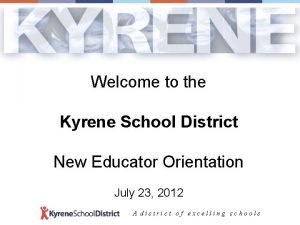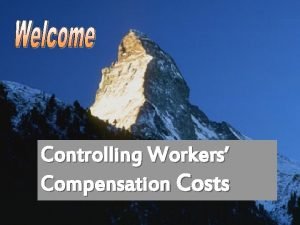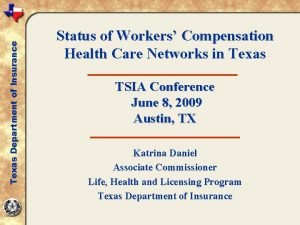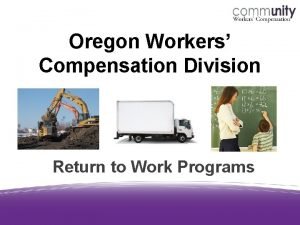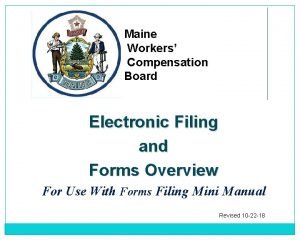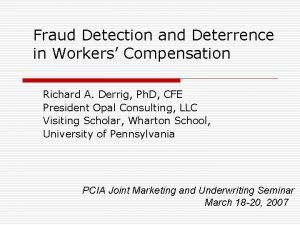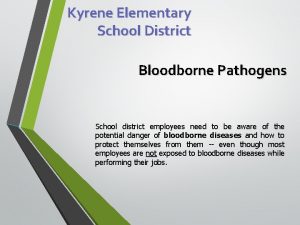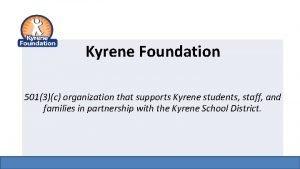Kyrene School District Work Safety Workers Compensation 1









- Slides: 9

Kyrene School District Work Safety & Workers Compensation 1

Workers Compensation is A no fault insurance that employers are required to provide to their employees. The Alliance is the Kyrene Workers Compensation (WC) insurance carrier. Employee Reporting Requirement • Employees are required to report any industrial injury or illness immediately to their site administrator or supervisor. Seek medical attention if needed. Employer / Supervisor Requirement • Discuss the injury with the employee and call the Workers Compensation Nurse Triage line together. Determine if the accident could have been prevented. Take appropriate steps to correct the situation if the accident was preventable. All claims should be reported within 24 -48 hours. This begins the investigation and assists with the timely payment of any WC medical or wage benefits. The Alliance files the claim with the Industrial Commission. 2

Workers Compensation Wages Workers Compensation (WC) Wages Not all work injuries will result in payment of wages. • If an employee is authorized off work by a physician due to a work injury, he/she must be off work over 7 days before WC wages will be paid. • Employees will use their accrued ACA for absences not covered by WC wages. • The 7 day waiting period will be retroactively paid to the employee if the employee is off work longer than 14 calendar days due to the work injury. ─ WC pays out 66 2/3% of an employee’s average monthly salary ─ WC is capped at $3, 763. 44. If the average monthly salary is higher, the maximum paid is 66 2/3% of $3, 763. 44 3

Slip Hazards Common causes of slip hazards spilled food or drink freshly-mopped floors ice or snow sand or fine gravel accumulations When a slip hazard is identified, it is best to contact the building custodian and your site administrator or secretary, or clean the spill yourself. If possible, do not leave the slip hazard unattended.

Trip Hazards Common causes of tripping hazards misaligned sections of a walking surface flexible cord within the walkway items improperly stored within the walkway obstructed view improper footwear bypassing designated walkways (taking shortcuts) When a trip hazard is identified, it is very important to notify the building custodian and your site administrator or secretary immediately. Some trip hazards (e. g. , cords within walkways, poor housekeeping, and improper footwear) can be quickly and easily resolved. 5

Fall Hazards Common fall hazards standing on desks, chairs, and/or stools improper use of a stepstool and/or stepladder unguarded, elevated walking surfaces participating in sports/field day events with students Injuries due to falls can be avoided through the proper use of available tools (e. g. , stepstools and stepladders) and by avoiding the use of desks, chairs, or other unsuitable objects to reach higher areas. Use caution when participating in student activities and be aware of your fitness level prior to participating. 6

Fall Hazards An employee is using an improper tool to reach a higher elevation. Also, this employee is wearing footwear that is not recommended. 7

Recommended Tools Stepstools Stepladder Flat-soled, closed-toed, and preferably slip-resistant footwear 8

Safety Tips Always look approximately six feet in front of you when walking. This will help you identify hazards. Use handrails wherever they are provided. Rotate your body 30° toward the handrail when descending stairs. This will increase your stability. Use extreme caution when participating in physical activities with students, such as PE class or “field day” events. Inspect ladders before each use. Post warning signs indicating a wet or slippery floor whenever possible. Report any possible safety hazards to your administrator/ supervisor.
